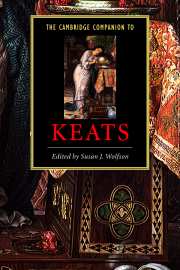Book contents
- Frontmatter
- 1 The politics of Keats’s early poetry
- 2 Endymion’s beautiful dreamers
- 3 Keats and the “Cockney School”
- 4 Lamia, Isabella, and The Eve of St. Agnes
- 5 Hyperion, The Fall of Hyperion, and Keats’s epic ambitions
- 6 Keats and the ode
- 7 Late lyrics
- 8 Keats’s letters
- 9 Keats and language
- 10 Keats’s sources, Keats’s allusions
- 11 Keats and “ekphrasis”
- 12 Keats and English poetry
- 13 Byron reads Keats
- 14 Keats and the complexities of gender
- 15 Keats and Romantic science
- 16 The “story” of Keats
- 17 Bibliography and further reading
- Index
16 - The “story” of Keats
Published online by Cambridge University Press: 28 May 2006
- Frontmatter
- 1 The politics of Keats’s early poetry
- 2 Endymion’s beautiful dreamers
- 3 Keats and the “Cockney School”
- 4 Lamia, Isabella, and The Eve of St. Agnes
- 5 Hyperion, The Fall of Hyperion, and Keats’s epic ambitions
- 6 Keats and the ode
- 7 Late lyrics
- 8 Keats’s letters
- 9 Keats and language
- 10 Keats’s sources, Keats’s allusions
- 11 Keats and “ekphrasis”
- 12 Keats and English poetry
- 13 Byron reads Keats
- 14 Keats and the complexities of gender
- 15 Keats and Romantic science
- 16 The “story” of Keats
- 17 Bibliography and further reading
- Index
Summary
The “story” of Keats - how a young man of no apparent distinction in family or social origins, education, or early accomplishments, grew up to become one of the ten or twelve most admired poets in all of English literature - is really several stories, some of them not entirely consistent or compatible with some of the others.1 This chapter focuses on two. The first is the story of Keats the young genius whose life and career were cut short - some said by the hostility of reviewers - just as he was about to produce the major works that his friends thought him capable of. This is the Keats of Shelley's Adonais; of Byron's famous quip in Canto 11 of Don Juan that Keats's “mind, that very fiery particle,” was “snuffed out by an article”; and of the inscriptions on his gravestone in the Protestant Cemetery in Rome: the broken lyre symbolizing unfulfilled aspirations; the words that the poet himself requested, “Here lies one whose name was writ in water”; and his friends' well-meant embellishments mentioning the poet's “bitterness [. . .] of heart, at the malicious power of his enemies.” The product of this first “story” is the Keats whom the British public thought of, if they remembered him at all, during the first three decades following his death on 23 February 1821.
- Type
- Chapter
- Information
- The Cambridge Companion to Keats , pp. 246 - 260Publisher: Cambridge University PressPrint publication year: 2001
- 8
- Cited by



